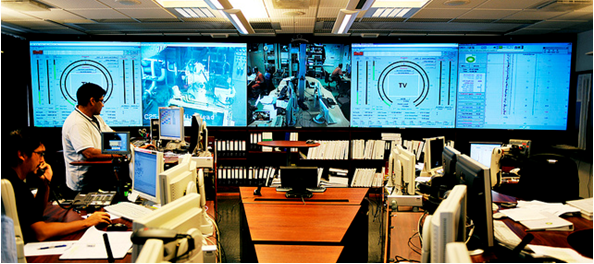Check and Act are essential part of continuous improvement for both the energy management system and the activities that influence the energy performance. Monitoring and measuring are the starting point for subsequently being able to implement corrective and preventive measures.
![]() What should be done
What should be done
Regular comparison of the actual energy consumption in relation to the expectation makes it easier to detect deviations. This requires systems and processes for data collection, analysis of data, and treatment of deviations.
Monitoring and measuring
Monitoring and measuring should provide a picture of how the installation operates in relation to established KPIs and goals. This is a continuous activity and can, for example, be done through:
- Establishing monitoring/measurement of equipment, processes and overall values.
- Using energy modelsfor continuous monitoring of the energy consumption against the model and correct when there are deviations.
- Using an energy measurement board to show measurements of the energy consumption for different processes and systems.
- Carry out conformity assessment in relation to legislation, regulations and standards.
The frequency for monitoring and measuring is dependent on what is measured, but can be:
- Continuous real-time monitoring (energy consumption and efficiency).
- Daily (energy consumption and efficiency).
- Weekly (energy consumption and efficiency).
- Monthly (energy consumption and efficiency/energy management).
- Quarterly (energy consumption and efficiency/energy management).
- Annually (energy consumption and efficiency/energy management).
Benchmarking with other installations within the company may reveal further room for improvement – learn from each other.
| Energy measurement plan |
|---|
|
An energy measurement plan shall be established as part of the energy management system. It should contain the following sections:
|
| What should be monitored? |
|---|
|
Many parameters can be measured and monitored. Focus on:
|

Analyse the results
The activities of monitoring and measuring provide basic information that must be analysed and compared. Consider the following activities:
- Analyse relative to energy consumption, energy baseline, legal requirements and other requirements, related energy factors (such as temperature, pressure, production level, etc.) and energy performance indicators (KPI) (weekly / monthly / yearly).
- Evaluate daily expected and actual energy consumption (daily).
- Assess the effectiveness of the action plan in achieving objectives and targets (monthly / quarterly / yearly).
- Document and visualising in the line organization (daily / weekly meetings).
Define and identify deviations
A definition of deviations should be established before deviations can be identified. In addition, the measurements must be compared to reference values. Consider the following activities:
- Define categories and type of energy deviations, both related to the energy management system and the energy use.
- Continuously identify deviations:
- Energy use and efficiency (should be done daily).
- Energy management system (should be done regularly through internal audits).
- Review the effect of the implemented improvement actions.
![]() Who should be involved
Who should be involved
The persons to be involved depend on the objective of the activity, for example:
- Daily control: operational personnel
- Weekly control: engineers and operations manager
- Monthly control: management representative
The energy manager and the energy team should be involved in the control of the energy management system.

![]() What should be documented
What should be documented
For monitoring and measuring, the following should be documented:
- The main findings from the analysis of monitoring and measurements.
- Results of the conformity assessment in relation to legislation, regulations and standards. This should be a living document with updates.
- Identified deviations related to both the energy management system and energy efficiency.
There should be system to maintain registration and documentation of deviations. The documentation should include a description of the actual deviation or risk of deviation, as well as reasons for the deviation.
An energy measurement plan should also be drawn up and implemented, appropriate to the size and complexity of the organisation.
![]() Challenges and opportunities
Challenges and opportunities
Do you have tips for integrating the control elements for energy management and energy efficiency within the existing procedures?
- Visibility / visualization: Important to communicate the results of the monitoring and measurements.
- Follow-up: When implementing control in existing procedures, there is less risk that the monitoring and measurement are not followed up.
- Establishing reliable systems: By establishing good systems for continuous measurement and analysis, the information and knowledge make it easier to strengthen the energy culture in the organisation. The part on controlling must be regarded as a process of continuous improvement.
How to establish an efficient energy measurement plan and analysis tool?
- Establishing: By establishing an efficient energy measurement plan, the correct parameters are measured at the correct time. It is also important to ensure that the data is reliable.
- Analysis: Defect in model and analysis tool for visualising in realtime with relation to measurement and verification uncertainty.
- Increase the interest and focus from management: Good measurements and analysis provide better basis for decision-making for management.
- Analysis of causes is often inadequately documented: In order to implement lasting and correct actions, it is important to carry-out an analysis of causes to identify, assess and eliminate the underlying causes of the problems.
How to carry out conformity assessments in relation to legislation, regulations, and standards?
For carrying out conformity assessments you can use established systems similar to those that already exist in HSE (for example internal audits, safety inspections, measurement and control, follow-up of energy contracts, etc.).
![]() Where do you find this in ISO 50001?
Where do you find this in ISO 50001?
- Chapter 4.6 Checking
- Chapter 4.6.1 Monitoring, measurement and analysis
- Chapter 4.6.5 Control of records
- Appendix A.6 Checking

